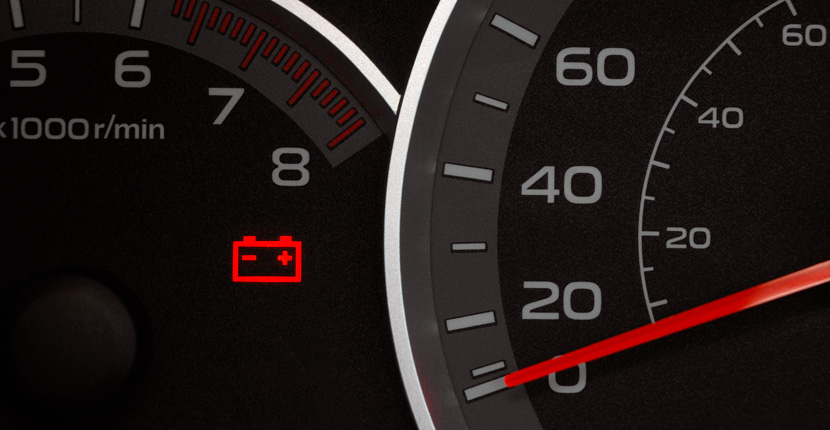Is It Okay to Drive When the Battery Light Is Lit Up on Your Dashboard?
- by Joe Weber - updated on 6/26/2023

The battery light indicates a problem with your car's electrical system. If you continue to drive, you could experience a loss of electrical power, which could lead to a number of problems. Keep reading to learn more about this indicator and what to do if it comes on.
What Does the Battery Light Mean?
The battery light is typically a symbol of a battery that is usually located in your car's dashboard, near other warning lights such as the oil pressure light and the temperature gauge.
When the battery light comes on, it could be due to several reasons you'll learn in a second. But, bottom line, this is telling you that there is a problem with your vehicle's battery or charging system. You should stop driving the car until you determine what the problem is and fix it.
What About When the Light Comes On When I Start the Car?
If the light comes on and immediately goes away as soon as you start the car, don't worry! It's perfectly normal for that and other lights to illuminate before and while you are starting the car. As long as the light goes off after the car is started, you're in the clear.
What Could Make the Battery Light Come On?
There are several reasons why your battery light might come on.
- Loose or corroded battery cables
- Corrosion build-up on the battery terminals
- Damaged cells or plates inside the battery
- Damaged wiring in the car's electrical harness
- Problems with the alternator or voltage regulator
- Other electrical problems
Why Shouldn't You Drive With the Battery Light On?
Driving with the battery light on can damage your car in several ways if it's not addressed quickly.
- It can put extra strain on the battery, which can shorten its lifespan.
- It can cause other electrical components in your car to fail.
- It can lead to a breakdown, leaving you stranded, especially when driving in hot weather or if you are using a lot of electrical power, such as using the air conditioning or the radio.
What Should You Do If the Battery Light Comes On?
If your battery light comes on, the smart thing to do is stop driving the car. Continuing to drive the vehicle on a regular basis could cause extensive problems if the cause of the issue isn't resolved.
After you park the car there are a couple of things that you can do yourself at home to try and remedy the problem.
1. Check for corrosion
Lead-acid batteries are likely to accumulate corrosion on the terminals and terminal connectors from normal use. Especially in warmer climates and during the summer. To check for corrosion, remove any protective covers from the battery terminals. If you see white, green or sometimes blue crystals on and around the terminals, congratulations! You've got corrosion.
Corrosion can interfere with the conductivity of electricity between the battery and the rest of the electrical system of the car. Remember to never touch corrosion with your bare hand as it can cause skin irritation. Put on some rubber gloves and jump into the next step.
2. Clean the terminals
Now that you've got your gloves on, let's remove that pesky corrosion and make sure it doesn't come back.
Disconnect the battery by unfastening the negative terminal first, then the positive. Make sure that the cables are secured so there is no accidental connection with the terminals to avoid sparks while you are working.
Using a terminal cleaning kit, spray the terminals with the cleaning spray, and with the included wire brush, scrub the terminals to remove the corrosion. Spray the terminal connectors with the cleaning spray and pop off the end of the brush and use the elongated scrubbing brush to clean out the clamps.
When the terminals and clamps are nice and clean, spray them both with the included terminal protection spray to help prevent new corrosion from forming. Once that is all said and done, reconnect your battery by connecting the positive terminal first, then the negative. Make sure the clamps are secured and not loose.
3. Tighten the battery clamps
Sometimes, after a while, the terminal clamps can loosen due to vibrations in the engine compartment. If you notice that the clamps are loose, even just slightly, tighten the terminal clamps using a wrench so they are secured tightly to the battery terminals.
Routinely checking for corrosion and removing any that may be there is a great way to help keep your battery healthy and to squeeze a little extra life out of it for the longest life possible.
What Should I Do If the Light is Still On?
If after doing all of that, you start your car and that warning light is still lit up like a Christmas tree, it might be time to take it in to have it looked at. Your first stop should be to your local Batteries Plus to have your battery tested, free of charge.
If your battery is bad and needs to be replaced, we carry a large variety of car and truck batteries from Duracell Ultra, Optima and our exclusive premium battery brand X2Power.
If your battery is still good, you should drive your car over to your mechanic or choice to have it looked at before things get worse. Your mechanic will be able to diagnose the problem and recommend repairs to bring your vehicle back to health.